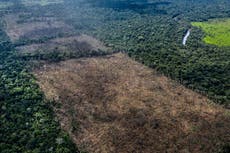Preventing destruction of ancient trees ‘helps buffer impacts of climate crisis’, study finds
Mapping and protecting old growth forests requires international collaboration between governments, researchers say

The world’s trees are in a perilous state with around ten million hectares of forest – roughly the size of Portugal – cut down every year.
Humans have cut down about a third of all forest on the planet in the last 6,000 years, with devastating effects on the ability of our world to absorb carbon dioxide.
Now a study has stressed the importance of ancient trees in helping to tackle our current climate crisis.
Species such as bristlecone pines in the White Mountains, USA, can live up to 5,000 years and act as massive carbon sequestration and storage facilities, while simultaneously providing rich ecosystems for other flora and fauna.
“Ancient trees are unique habitats for the conservation of threatened species because they can resist and buffer climate warming,” said a study, by Charles Cannon, from the Centre for Tree Science in Illinois and Ecologist Gianluca Piovesan.
“Mapping and monitoring old-growth forests and ancient trees can directly assess the effectiveness and sustainability of protected areas and their ecological integrity,” the researchers said.
They are calling for an international effort to monitor and protect the world’s remaining old-growth forests.
“To carry out this ambitious project, a global monitoring platform, based on advanced technologies, is required along with public contributions through community science projects,” they said.
The researchers warned that opportunities for protecting ancient trees in forests, woodlands, historic gardens, and urban and agricultural areas remain highly limited without further actions by national governments around the world.
The current review of the UN’s efforts to protect the natural world "should include old-growth and ancient tree mapping and monitoring as key indicators of the effectiveness of protected areas in maintaining and restoring forest integrity for a sustainable future,” the authors said.
“We call for international efforts to preserve these hubs of diversity and resilience. A global coalition utilising advanced technologies and community scientists to discover, protect, and propagate ancient trees is needed before they disappear.”
The research is published in the journal Trends in Ecology & Evolution.
Join our commenting forum
Join thought-provoking conversations, follow other Independent readers and see their replies
Comments


Bookmark popover
Removed from bookmarks